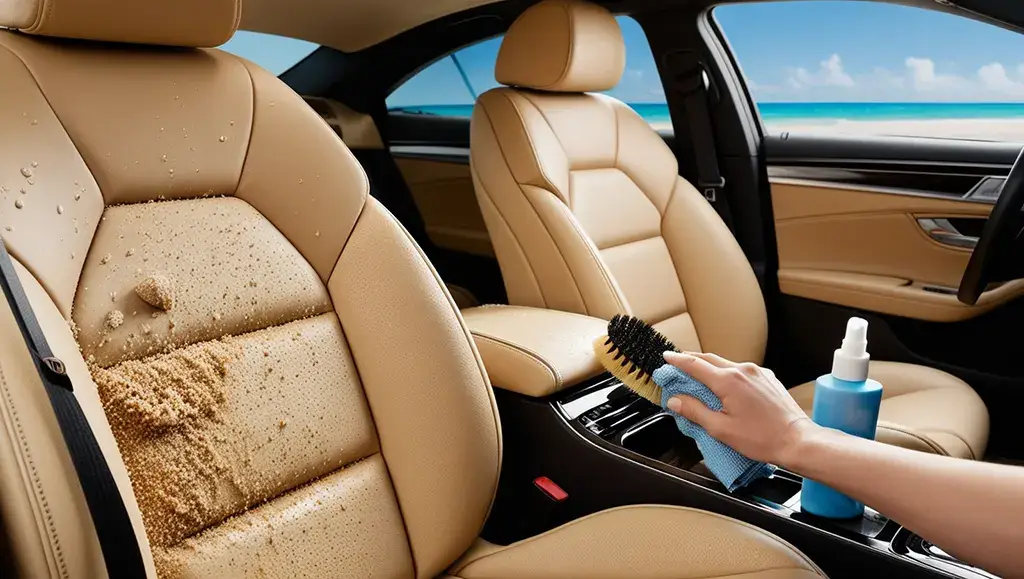Discover effective techniques and tips on how to keep leather car seats clean after the beach. Protect your car’s interior from sand, salt, and moisture damage. A day at the beach is a perfect way to relax and unwind, but returning to your car with sandy feet and damp swimwear can spell trouble for your leather seats. Learning how to keep leather car seats clean after the beach is essential for maintaining your vehicle’s interior and preserving its value. In this comprehensive guide, we’ll explore various methods and preventive measures to ensure your leather seats remain pristine even after a sun-soaked day by the shore. Understanding the Challenges of Beach-Related Leather Seat Damage Before diving into the cleaning techniques, it’s crucial to understand the potential threats that beach outings pose to your leather car seats. Sand, salt water, and excessive moisture can wreak havoc on leather surfaces if left unattended. Sand particles can act like tiny abrasives, scratching and dulling the leather’s finish. Salt from seawater can dry out and crack the leather, while moisture can lead to mold and mildew growth. By recognizing these risks, you’ll be better equipped to tackle the challenge of how to keep leather car seats clean after the beach. The Impact of Sand on Leather Seats Sand is perhaps the most visible and immediate threat to your leather seats after a beach trip. These tiny particles can easily become embedded in the leather’s pores and seams, causing discomfort and potential long-term damage. As you shift in your seat or brush against the leather, sand can create micro-scratches that accumulate over time, leading to a worn and aged appearance. Additionally, sand can work its way into the seat mechanisms, potentially causing issues with adjustability and overall functionality. The Corrosive Effects of Salt Water While less apparent than sand, salt water can be equally damaging to leather car seats. When seawater evaporates, it leaves behind salt crystals that can draw moisture out of the leather, causing it to dry out and potentially crack. This process can significantly shorten the lifespan of your leather seats if not addressed promptly. The salt residue can also create a whitish, chalky appearance on the leather surface, detracting from its aesthetic appeal. How to Keep Leather Car Seats Clean After the Beach Prevention is always better than cure when it comes to maintaining your car’s interior. By taking a few simple precautions, you can significantly reduce the amount of cleaning and maintenance required after your beach outings. Here are some essential preventive measures to consider when learning how to keep leather car seats clean after the beach: Use Seat Covers or Towels One of the most effective ways to protect your leather seats is to cover them before heading to the beach. Consider investing in waterproof seat covers specifically designed for beach use. These covers can be easily removed and washed, keeping sand and moisture away from your leather seats. If you don’t have seat covers, large beach towels can serve as a temporary solution. Simply drape them over your seats before getting in the car, and shake them out thoroughly before removing them. Rinse Off Before Entering the Car Many beaches have outdoor showers or foot-washing stations. Make use of these facilities to rinse off excess sand and salt water before getting into your car. Pay special attention to your feet, as they’re likely to carry the most sand. If no shower is available, keep a large bottle of fresh water and a small towel in your car for a quick rinse and dry-off before entering. Change Out of Wet Swimwear Whenever possible, change out of wet swimwear before getting into your car. Wet bathing suits can transfer moisture to your leather seats, potentially leading to water stains or mold growth. If changing isn’t an option, sit on a towel to create a barrier between your damp clothing and the leather seats. Immediate Post-Beach Cleaning Even with preventive measures in place, some sand and moisture may still find their way onto your leather seats. Taking immediate action once you return home is crucial in maintaining your seats’ cleanliness and condition. Here’s a step-by-step guide on how to keep leather car seats clean after the beach: 1. Remove loose sand: – Use a soft-bristled brush or vacuum cleaner with a brush attachment – Gently brush or vacuum the entire seat surface, paying extra attention to seams and crevices – Don’t forget to clean the floor mats and carpets as well 2. Wipe down the seats: – Use a slightly damp microfiber cloth to remove any remaining sand or salt residue – Avoid saturating the leather; the cloth should be just moist enough to pick up particles 3. Dry thoroughly: – Use a clean, dry microfiber cloth to remove any excess moisture – Ensure all areas are completely dry to prevent water stains or mold growth 4. Apply leather cleaner: – Use a pH-neutral leather cleaner specifically designed for automotive use – Follow the manufacturer’s instructions for application – Work the cleaner into the leather using gentle circular motions 5. Condition the leather: – After cleaning, apply a high-quality leather conditioner to restore moisture and protect the surface – Use sparingly; a little goes a long way – Allow the conditioner to absorb fully before using the seats Long-Term Maintenance Learning how to keep leather car seats clean after the beach is not just about immediate care; it’s also about establishing a long-term maintenance routine. Regular upkeep can extend the life of your leather seats and keep them looking their best for years to come. Here are some tips for long-term leather seat maintenance: Regular Cleaning Schedule Establish a regular cleaning schedule for your leather seats, even when you haven’t been to the beach. A weekly quick clean and a monthly deep clean can go a long way in preventing dirt and grime buildup. Use a leather-specific cleaner and follow up with a conditioner to keep the leather supple and protected.





